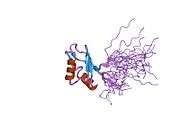IGF2BP2
Insulin-like growth factor 2 mRNA-binding protein 2 is a protein that in humans is encoded by the IGF2BP2 gene.[5][6][7]
This gene encodes a member of the IGF-II mRNA-binding protein (IMP) family. The protein encoded by this gene contains several four KH domains and two RRM domains. It functions by binding to the 5' UTR of the insulin-like growth factor 2 (IGF2) mRNA and regulating IGF2 translation. Alternate transcriptional splice variants, encoding different isoforms, have been characterized.[7]
References
- 1 2 3 GRCh38: Ensembl release 89: ENSG00000073792 - Ensembl, May 2017
- 1 2 3 GRCm38: Ensembl release 89: ENSMUSG00000033581 - Ensembl, May 2017
- ↑ "Human PubMed Reference:".
- ↑ "Mouse PubMed Reference:".
- ↑ Zhang JY, Chan EK, Peng XX, Tan EM (May 1999). "A novel cytoplasmic protein with RNA-binding motifs is an autoantigen in human hepatocellular carcinoma". J Exp Med. 189 (7): 1101–10. doi:10.1084/jem.189.7.1101. PMC 2193003. PMID 10190901.
- ↑ Nielsen J, Christiansen J, Lykke-Andersen J, Johnsen AH, Wewer UM, Nielsen FC (Feb 1999). "A family of insulin-like growth factor II mRNA-binding proteins represses translation in late development". Mol Cell Biol. 19 (2): 1262–70. PMC 116055. PMID 9891060.
- 1 2 "Entrez Gene: IGF2BP2 insulin-like growth factor 2 mRNA binding protein 2".
Further reading
- Yisraeli JK (2005). "VICKZ proteins: a multi-talented family of regulatory RNA-binding proteins". Biol. Cell. 97 (1): 87–96. doi:10.1042/BC20040151. PMID 15601260.
- Strausberg RL, Feingold EA, Grouse LH, et al. (2003). "Generation and initial analysis of more than 15,000 full-length human and mouse cDNA sequences". Proc. Natl. Acad. Sci. U.S.A. 99 (26): 16899–903. doi:10.1073/pnas.242603899. PMC 139241. PMID 12477932.
- Moraes KC, Quaresma AJ, Maehnss K, Kobarg J (2003). "Identification and characterization of proteins that selectively interact with isoforms of the mRNA binding protein AUF1 (hnRNP D)". Biol. Chem. 384 (1): 25–37. doi:10.1515/BC.2003.004. PMID 12674497.
- Brants JR, Ayoubi TA, Chada K, et al. (2004). "Differential regulation of the insulin-like growth factor II mRNA-binding protein genes by architectural transcription factor HMGA2". FEBS Lett. 569 (1–3): 277–83. doi:10.1016/j.febslet.2004.05.075. PMID 15225648.
- Ping S, Wang S, Zhang J, Peng X (2005). "Effect of all-trans-retinoic acid on mRNA binding protein p62 in human gastric cancer cells". Int. J. Biochem. Cell Biol. 37 (3): 616–27. doi:10.1016/j.biocel.2004.08.007. PMID 15618018.
- Hammer NA, Hansen TO, Byskov AG, et al. (2005). "Expression of IGF-II mRNA-binding proteins (IMPs) in gonads and testicular cancer". Reproduction. 130 (2): 203–12. doi:10.1530/rep.1.00664. PMID 16049158.
- Natkunam Y, Vainer G, Chen J, et al. (2007). "Expression of the RNA-binding protein VICKZ in normal hematopoietic tissues and neoplasms". Haematologica. 92 (2): 176–83. doi:10.3324/haematol.10724. PMID 17296566.
- Ewing RM, Chu P, Elisma F, et al. (2007). "Large-scale mapping of human protein-protein interactions by mass spectrometry". Mol. Syst. Biol. 3 (1): 89. doi:10.1038/msb4100134. PMC 1847948. PMID 17353931.
- Cleynen I, Brants JR, Peeters K, et al. (2007). "HMGA2 regulates transcription of the Imp2 gene via an intronic regulatory element in cooperation with nuclear factor-kappaB". Mol. Cancer Res. 5 (4): 363–72. doi:10.1158/1541-7786.MCR-06-0331. PMID 17426251.
This article is issued from
Wikipedia.
The text is licensed under Creative Commons - Attribution - Sharealike.
Additional terms may apply for the media files.






